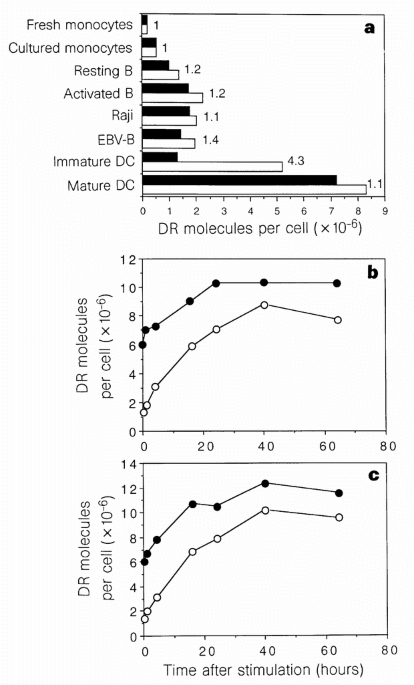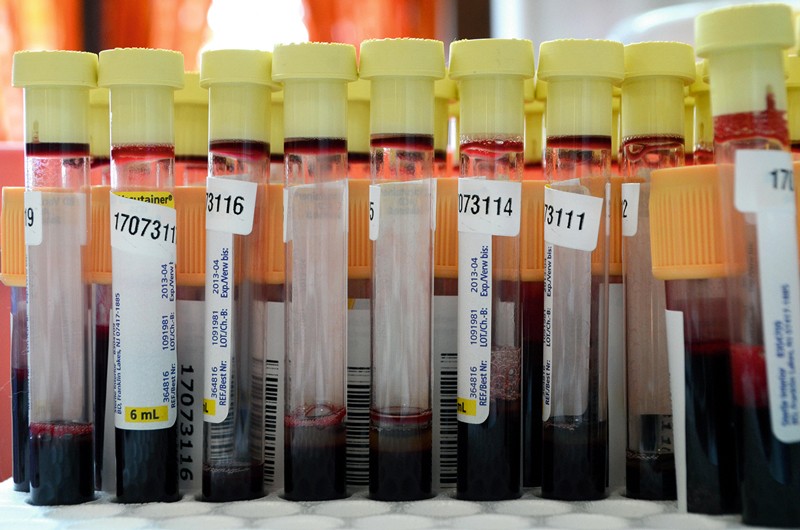
- Select a language for the TTS:
- UK English Female
- UK English Male
- US English Female
- US English Male
- Australian Female
- Australian Male
- Language selected: (auto detect) - EN
Play all audios:
ABSTRACT Dendritic cells have the remarkable property of presenting any incoming antigen1. To do so they must not only capture antigens with high efficiency and broad specificity, but must
also maximize their capacity to load class II molecules of the major histocompatibility complex (MHC) with antigenic peptides in order to present a large array of epitopes from different
proteins, each at a sufficient copy number. Here we show that formation of peptide–MHC class II complexes is boosted by inflammatory stimuli that induce maturation of dendritic cells. In
immature dendritic cells, class II molecules are rapidly internalized and recycled, turning over with a half-life of about 10 hours. Inflammatory stimuli induce a rapid and transient boost
of class II synthesis, while the half-life of class II molecules increases to over 100 hours. These coordinated changes result in the rapid accumulation of a large number of long-lived
peptide-loaded MHC class II molecules capable of stimulating T cells even after several days. The capacity of dendritic cells to load many antigenic peptides over a short period of initial
exposure to inflammatory stimuli could favour presentation of infectious antigens. Access through your institution Buy or subscribe This is a preview of subscription content, access via your
institution ACCESS OPTIONS Access through your institution Subscribe to this journal Receive 51 print issues and online access $199.00 per year only $3.90 per issue Learn more Buy this
article * Purchase on SpringerLink * Instant access to full article PDF Buy now Prices may be subject to local taxes which are calculated during checkout ADDITIONAL ACCESS OPTIONS: * Log in
* Learn about institutional subscriptions * Read our FAQs * Contact customer support SIMILAR CONTENT BEING VIEWED BY OTHERS STRIKING A BALANCE: NEW PERSPECTIVES ON HOMEOSTATIC DENDRITIC CELL
MATURATION Article 17 September 2024 CD4+ T CELL MEMORY Article 08 May 2023 TONEBP IN DENDRITIC CELLS MEDIATES PRO-INFLAMMATORY MATURATION AND TH1/TH17 RESPONSES Article Open access 04 June
2020 REFERENCES * Steinman, R. M. The dendritic cell system and its role in immunogenicity. _Annu. Rev. Immunol._ 9, 271–296 (1991). Article CAS Google Scholar * Pure, E._et al_. Antigen
processing by epidermal Langerhans cells correlates with the level of biosynthesis of major histocompatibility complex class II molecules and expression of invariant chain. _J. Exp. Med._
172, 1459–1469 (1990). Article CAS Google Scholar * Roake, J. A._et al_. Dendritic cell loss from nonlymphoid tissues after systemic administration of lipopolysaccharide, tumor necrosis
factor, and interleukin 1. _J. Exp. Med._ 181, 2237–2247 (1995). Article CAS Google Scholar * Stossel, H._et al_. Disappearance of certain acidic organelles (endosomes and Langerhans cell
granules) accompanies loss of antigen processing capacity upon culture of epidermal Langerhans cells. _J. Exp. Med._ 172, 1471–1482 (1990). Article CAS Google Scholar * Kampgen, E._et
al_. Class II major histocompatibility complex molecules of murine dendritic cells: synthesis, sialylation of invariant chain, and antigen processing capacity are down-regulated upon
culture. _Proc. Natl Acad. Sci. USA_ 88, 3014–3018 (1991). Article ADS CAS Google Scholar * Enk, A. H. & Katz, S. I. Early molecular events in the induction phase of contact
sensitivity. _Proc. Natl Acad. Sci. USA_ 89, 1398–1402 (1992). Article ADS CAS Google Scholar * Sallusto, F. & Lanzavecchia, A. Efficient presentation of soluble antigen by cultured
human dendritic cells is maintained by granulocyte/macrophage colony-stimulating factor plus interleukin 4 and downregulated by tumor necrosis factor alpha. _J. Exp. Med._ 179, 1109–1118
(1994). Article CAS Google Scholar * Sallusto, F., Cella, M., Danieli, C. & Lanzavecchia, A. Dendritic cells use macropinocytosis and the mannose receptor to concentrate
macromolecules in the major histocompatibility complex class II compartment: downregulation by cytokines and bacterial products. _J. Exp. Med._ 182, 389–400 (1995). Article CAS Google
Scholar * Davidson, H. W., Reid, P. A., Lanzavecchia, A. & Watts, C. Processed antigen binds to newly synthesized MHC class II molecules in antigen-specific B lymphocytes. _Cell_ 67,
105–116 (1991). Article CAS Google Scholar * Pinet, V., Vergelli, M., Martin, R., Bakke, O. & Long, E. O. Antigen presentation mediated by recycling of surface HLA-DR molecules.
_Nature_ 375, 603–606 (1995). Article ADS CAS Google Scholar * Pinet, V., Malnati, M. S. & Long, E. O. Two processing pathways for the MHC class II-restricted presentation of
exogenous influenza virus antigen. _J. Immunol._ 152, 4852–4860 (1994). CAS PubMed Google Scholar * Zhong, G., Romagnoli, P. & Germain, R. N. Related leucine-based cytoplasmic
targeting signals in Invariant chain and major histocompatibiity complex class II molecules control endocytic presentation of distinct determinants in a single protein. _J. Exp. Med._ 185,
429–438 (1997). Article CAS Google Scholar * Reid, P. A. & Watts, C. Cycling of cell-surface MHC glycoproteins through primaquine-sensitive intracellular compartments. _Nature_ 346,
655–657 (1990). Article ADS CAS Google Scholar * Neefjes, J. J., Stollorz, V., Peters, P. J., Geuze, H. J. & Ploegh, H. L. The biosynthetic pathway of MHC class II but not class I
molecules intersects the endocytic route. _Cell_ 61, 171–183 (1990). Article CAS Google Scholar * Roosnek, E., Demotz, S., Corradin, G. & Lanzavecchia, A. Kinetics of MHC–antigen
complex formation on antigen-presenting cells. _Immunol._ 140, 4079–4082 (1988). CAS Google Scholar * Lanzavecchia, A., Reid, P. A. & Watts, C. Irreversible association of peptides
with class II MHC molecules in living cells. _Nature_ 357, 249–252 (1992). Article ADS CAS Google Scholar * Nelson, C. A., Petzold, S. J. & Unanue, E. R. Peptides determine the
lifespan of MHC class II molecules in the antigen-presenting cell. _Nature_ 371, 250–252 (1994). Article ADS CAS Google Scholar * Amigorena, S., Drake, J. R., Webster, P. & Mellman,
I. Transient accumulation of new class II MHC molecules in a novel endocytic compartment in B lymphocytes. _Nature_ 369, 113–120 (1994). Article ADS CAS Google Scholar * Germain, R. N.
& Hendrix, L. R. MHC class II structure, occupancy and surface expression determined by post-endoplasmic reticulum antigen binding. _Nature_ 353, 134–139 (1991). Article ADS CAS
Google Scholar * Pierre, P._et al_. Developmental regulation of MHC class II transport in mouse dendritic cells. _Nature_ THIS ISSUE. EDS TO COMPLETE ON PAGE Download references
ACKNOWLEDGEMENTS We thank D. Scheidegger and M. Dessing for technical assistance, E. Long for discussion, and C. Watts, F. Sallusto, K. Karjalainen and M. Colonna for critically reading the
manuscript. The Basel Institute for Immunology was founded and is supported by F. Hoffmann-La Roche, Basel, Switzerland. AUTHOR INFORMATION AUTHORS AND AFFILIATIONS * Basel Institute for
Immunology, Grenzacherstrasse 487, CH 4005, Basel, Switzerland Marina Cella, Anneke Engering, Jean Pieters & Antonio Lanzavecchia * Laboratoire d'Immunologie, Inserm U-291, Hôpital
Saint Eloi, 34295, Montpellier, France Valerie Pinet Authors * Marina Cella View author publications You can also search for this author inPubMed Google Scholar * Anneke Engering View author
publications You can also search for this author inPubMed Google Scholar * Valerie Pinet View author publications You can also search for this author inPubMed Google Scholar * Jean Pieters
View author publications You can also search for this author inPubMed Google Scholar * Antonio Lanzavecchia View author publications You can also search for this author inPubMed Google
Scholar CORRESPONDING AUTHOR Correspondence to Marina Cella. RIGHTS AND PERMISSIONS Reprints and permissions ABOUT THIS ARTICLE CITE THIS ARTICLE Cella, M., Engering, A., Pinet, V. _et al._
Inflammatory stimuli induce accumulation of MHC class II complexes on dendritic cells. _Nature_ 388, 782–787 (1997). https://doi.org/10.1038/42030 Download citation * Received: 19 March 1997
* Accepted: 28 May 1997 * Issue Date: 21 August 1997 * DOI: https://doi.org/10.1038/42030 SHARE THIS ARTICLE Anyone you share the following link with will be able to read this content: Get
shareable link Sorry, a shareable link is not currently available for this article. Copy to clipboard Provided by the Springer Nature SharedIt content-sharing initiative





